|
Caring for your New Papillon
Forevr
Papillons sends care and health information to every new Papillon owner.
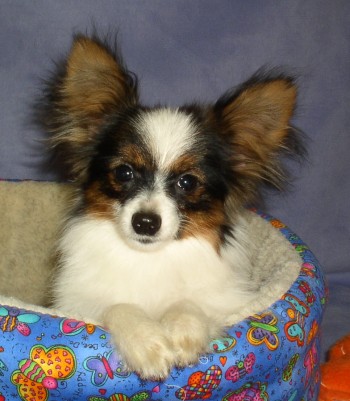 How
to care for a puppy... How
to care for a puppy...
Your puppy or dog has been carefully
raised and cared for until now. It is up to you to protect your puppy and
your investment by continuing the same type of care.
The following are
instructions for caring for your new Papillon.
Feeding
Feed a good quality dog food. Your
Forevr Puppy has been raised on Bil-Jac Frozen Food and Purina One
Sensitive System there are a number of other good dog foods available on
the market such as Science Diet, Pro Plan, Iams, Neutro etc. Feed 3 times
a day for a puppy up to 3 months and twice a day for a puppy under 6
months. Until 6 months of age we give a teaspoon of cottage cheese as a
natural source of calcium with their food each day. After that one meal a
day of quality kibble should be all it needs. A normal size adult Pap
should not eat more than ½ - 3/4 C of food a day. You may want to feed
moistened food mixed with the cottage cheese to your puppy, in the morning
and have dry food available through out the day. That is your choice. We
normally do not feed our adult dogs moistened food, as this can cause more
tartar to build up on the teeth. Feed only as much as your Papillon can
consume in that period, do not put day a week or several days of food.
Watch to make sure your dog is not gaining too much extra weight, as this
is a health hazard. Cow hooves, booda bones or nyla bones, chew puffs are
recommended for teething puppies and the safety of your furniture.
Housetraining
At Forevr we prefer to litter train
our puppies. Because we travel often occasionally we will have a litter
that is not litter trained, check with us to see how your dog has been
raised. (A litter training article is included in your Pap package.) Most
of our puppies and adults are doggie door trained. We find by doing both
methods it helps with housetraining later on. A young dog or puppy
requires a lot of rest and sleep. For this purpose it is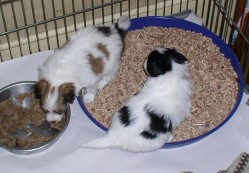 suggested that you purchase a 100 size dog crate. Dog crates can be
purchased from stores, such as Wal-Mart and K-Mart, catalogs and vendors
at dog shows. Line the bottom of your crate with newspaper, and put in a
crate pad or towel for comfort. Your puppy should be left undisturbed in
his crate for naps and eating his meals. If you choose to use the crate
method do not let a whining puppy coax you into letting them out of their
crate for naps or meals. Many times covering the crate with a sheet or a
towel will help darken the crate will help your Papillon settle down and
prevent them from seeing everything that may be going on around them.
suggested that you purchase a 100 size dog crate. Dog crates can be
purchased from stores, such as Wal-Mart and K-Mart, catalogs and vendors
at dog shows. Line the bottom of your crate with newspaper, and put in a
crate pad or towel for comfort. Your puppy should be left undisturbed in
his crate for naps and eating his meals. If you choose to use the crate
method do not let a whining puppy coax you into letting them out of their
crate for naps or meals. Many times covering the crate with a sheet or a
towel will help darken the crate will help your Papillon settle down and
prevent them from seeing everything that may be going on around them.
When your puppy
awakens, put him outside or on a newspaper immediately and praised him
highly when he relieves himself in the proper place. After the puppy has
finished, this is a good time to play with your dog.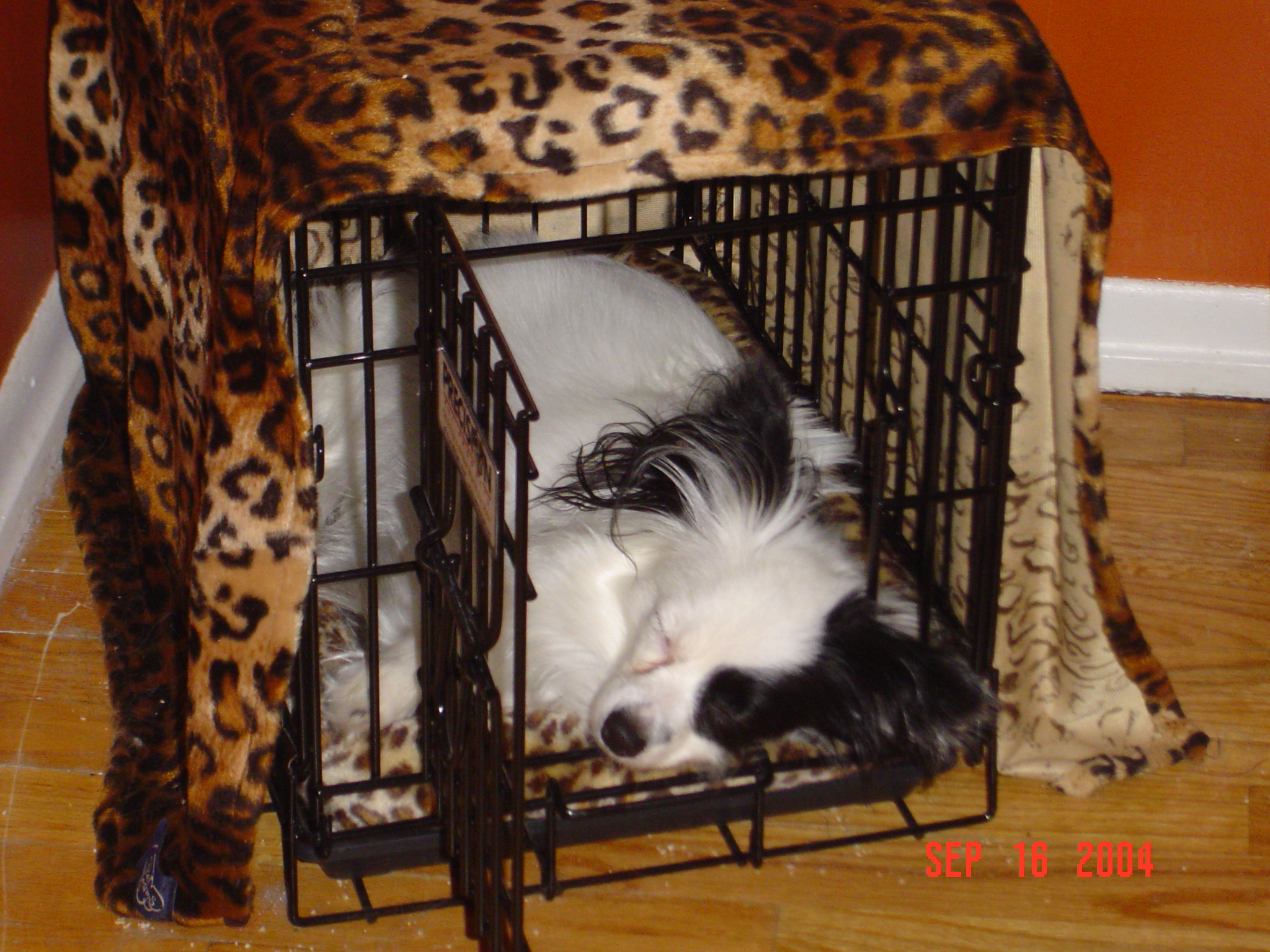 When play time is done always return the puppy to his crate. If you see
your puppy make a mistake in the house, show them the spot, tell them in a
firm voice the have been bad and immediately take them outside. Praise
him if he goes pee or poop outside. Do not ever strike or hit your dog to
correct him. This will only cause him to fear you and will not solve the
problem. Rubbing your dog’s nose in his stool or the pee spot will only
teaches them they don’t like their nose rubbed in it. Do not correct them
for soiling in the house, unless you catch them in the process. A dog’s
attention span is not long enough to take them back to the spot several
minutes later.
When play time is done always return the puppy to his crate. If you see
your puppy make a mistake in the house, show them the spot, tell them in a
firm voice the have been bad and immediately take them outside. Praise
him if he goes pee or poop outside. Do not ever strike or hit your dog to
correct him. This will only cause him to fear you and will not solve the
problem. Rubbing your dog’s nose in his stool or the pee spot will only
teaches them they don’t like their nose rubbed in it. Do not correct them
for soiling in the house, unless you catch them in the process. A dog’s
attention span is not long enough to take them back to the spot several
minutes later.
Car Rides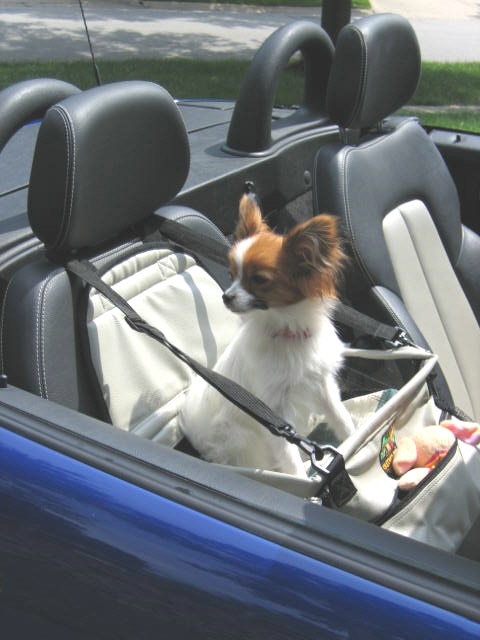
Always use a crate
to transport your dog. It is safe and could prevent the loss of your dogs
life if in an accident. Heck,
having your dogs in a crate could prevent the driver from having an
accident. If you are in a wreck, the dog being crated can prevent your dog
from running away if people open the car doors to assist you. We have
seen crated dogs remain unscratched when seat belted passengers have had
very serious injuries. We all know we don’t want our pet to be harmed in
or out of a moving vehicle. Please remember, DO NOT leave your dog in a
car, even if it is just warm and sunny outside. On a sunny 85 degree day
in a matter of minutes the temperature can reach 200 degrees in a closed
car even with the windows cracked,.
Health
There is no breed of dog, no matter
how healthy that may be who is immune to most infectious dise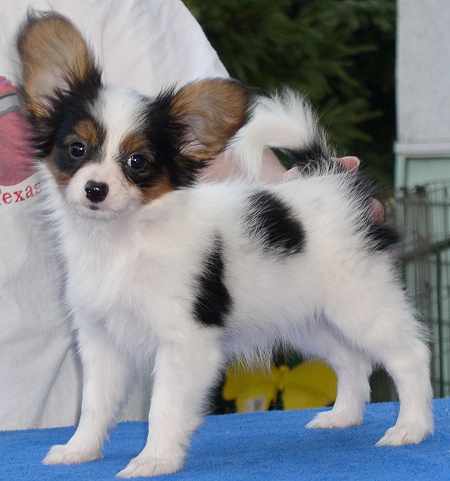 ases.
It is absolutely necessary that you continue with the immunization
schedule of your dog to protect him against these diseases. Any puppy less
than three months of age has been receiving puppy shots. If your puppy was
3 months old or older, at the time you took him home, he has multiple
vaccinations against distemper, hepatitis, parvo virus and parainfluenza.
He will also be vaccinated for Bordetella “kennel cough”. If your dog is
over 12 weeks of age, they will have had their initial rabies vaccination.
Although these are called "permanent" inoculations, they need to be
renewed annually for a puppy and bi annually each year there after. Please
discuss with your veterinarian the vaccination regimen he prefers. Rabies
requirements are different in different areas and states. We strongly urge
you to find a good toy dog veterinarian and talk to them about your pup’s
health and well being. Papillons can be prone to contagious diseases so
please be cautious where you take your dog. ases.
It is absolutely necessary that you continue with the immunization
schedule of your dog to protect him against these diseases. Any puppy less
than three months of age has been receiving puppy shots. If your puppy was
3 months old or older, at the time you took him home, he has multiple
vaccinations against distemper, hepatitis, parvo virus and parainfluenza.
He will also be vaccinated for Bordetella “kennel cough”. If your dog is
over 12 weeks of age, they will have had their initial rabies vaccination.
Although these are called "permanent" inoculations, they need to be
renewed annually for a puppy and bi annually each year there after. Please
discuss with your veterinarian the vaccination regimen he prefers. Rabies
requirements are different in different areas and states. We strongly urge
you to find a good toy dog veterinarian and talk to them about your pup’s
health and well being. Papillons can be prone to contagious diseases so
please be cautious where you take your dog.
If your puppy is
under 3 or 4 months of age, he will not have a rabies vaccination yet.
This should be addressed with your veterinarian with your first visit.
Many states require a vaccination at 3 to 6 months.
Check with your
veterinarian regarding a preventative program for heartworm. Many areas of
the country have problems with heartworm carrying mosquitoes and there are
a number of different products that prevent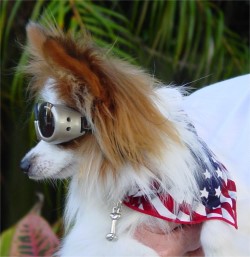 heartworm infections and are given monthly. The cure for heartworm is very
expensive and can cause death in many dogs and permanent long-term health
concerns.
heartworm infections and are given monthly. The cure for heartworm is very
expensive and can cause death in many dogs and permanent long-term health
concerns.
All our puppies
are wormed at least twice as a preventative measure. It is also prudent to
have your dog check periodically for internal parasites. Round, hook, whip
and tape worms can cause many health problems with dogs. There are heart
worm preventatives which now include a monthly wormer. Check with you vet
to see if they recommend this product. It is recommended that you keep
your yard as clean as possible of dog feces to prevent any infection or
re-infection by worms. And in dog parks try to keep your Papillon away
from stool that has not been picked up.
Identification
If you are receiving an adult Pap,
it will usually be micro chipped. Your new puppy may or may not be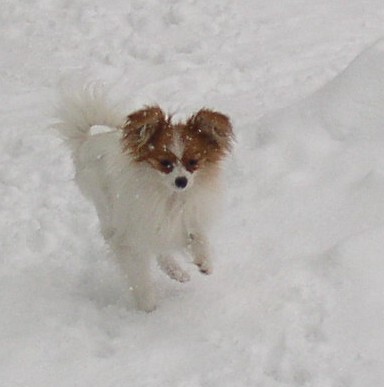 microchipped. For identification purposes we encourage you to have your
new Pap chipped, it may mean the difference of a quick recovery if they
happen to become separated from you. There are microchip clinics at dog
shows, kennel club meetings and most vets offer microchips as part of
their services.
microchipped. For identification purposes we encourage you to have your
new Pap chipped, it may mean the difference of a quick recovery if they
happen to become separated from you. There are microchip clinics at dog
shows, kennel club meetings and most vets offer microchips as part of
their services.
Please do not let
your Papillon run loose even though he wants to be with you as much as
possible. Please make sure that gates are latched when he is in your yard.
Never leave your dog outside while you are gone. You have a beautiful
elegant little dog and someone else might think so also. Do not leave your
Papillon outside in extremes of cold or heat. Papillions are not able to
stand long periods of extreme temperatures that could cause heatstroke or
pneumonia.
Keep in
contact
We are sincerely interested in the
progress of your Papillon. If you should at any time have any
 questions
or problems, please call or write Danny & Ruth Ann Ford, Also let us know
how you and your Papillon are
getting along. We know your experience of owning a Papillon will be most
rewarding. questions
or problems, please call or write Danny & Ruth Ann Ford, Also let us know
how you and your Papillon are
getting along. We know your experience of owning a Papillon will be most
rewarding.
Pictures
We love
pictures!!! Please send us pictures from time to time. When we have a
free moment we will include your picture and text on our great pet homes
page on our Showpaps.com website.
Need More
Pap Information?
Check our site
at www.showpaps.com it may already be there for your to read about.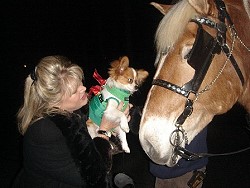
Litter
Training for Puppies
There are so many
advantages to litter training. Apartment dwellers with no yard can use a
litterbox, no need to walk a dog when staying in a hotel, or bad weather
prevents you and your dog from being outside for too long.
Please note,
Litter training is not meant to train your dog to never be able to go
potty outside. It is to be used to help assist young dogs while being
house trained. Puppies that are litter boxed trained can successfully use
a litter box and also go outside.
This is how we train our puppies...

At about 3 weeks
of age we put a cookie sheet with litter in the puppy pen. The puppies
will start quickly crawling over to the pan to go... Sometimes they have
the front legs in and the hind end hanging out of the pan, but hey! The
pups get an "A" for effort.
Around 5 weeks of age our little puppy furkids are starting to grow, climb
and play more. At this time we graduate them to a regular Dollar Store
$2.00 plastic cat litter pan. This inexpensive pan is what we suggest that
you purchase for your Pap puppy. Some people like to purchase a covered
cat pan to use in their home when male house dog starts to lift their leg.
We suggest that
you keep your puppy and the litter pan in a confined area, a puppy pen or
a shor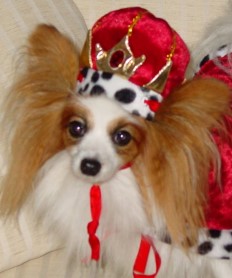 t
exercise pen works best. A small kitchen with a door or baby gate or
laundry room will also suffice. In their litter area the floor is lined
with paper, on top of the paper is clean bedding, toy, chewies food bowl,
water and the litter pan. We clean a minimum of two times a day by picking
out the stool and adding a little extra wood pellets. Change the litter
completely twice a week. If the pan doesn't stay clean the puppies will
tend to poop "out of the box" or make mistakes. t
exercise pen works best. A small kitchen with a door or baby gate or
laundry room will also suffice. In their litter area the floor is lined
with paper, on top of the paper is clean bedding, toy, chewies food bowl,
water and the litter pan. We clean a minimum of two times a day by picking
out the stool and adding a little extra wood pellets. Change the litter
completely twice a week. If the pan doesn't stay clean the puppies will
tend to poop "out of the box" or make mistakes.
As your dog gets
older and goes outside more and more to relieve itself many times they
will use their litter pan less and less. This is OK; it means they are
becoming more housetrained. Litter training is not a perfect system, but
we'd say works 75% of the time when they are lose in the kitchen and
almost 95% in their own rooms. It is important for you to remember that
dogs do not have the instinct of cats, they will not go out of a room and
down the hall to find their box. That is why the litter is used as a house
training device and not as a permanent toilet for your Pap.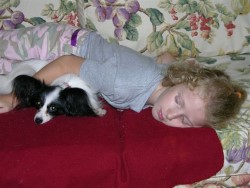
The pet owners that receive our pups, love
it!
The litter we prefer to use is called Woody Pet, we buy this at a store
called Tractor Supply, which is a national chain. It is about $5.00 for 30
lbs. What also works well is compressed wood pellets that is used for wood
burning stoves. It won’t hurt the puppies if they happen to consume some
and when they urinate on the litter it turns to sawdust. But after a taste
as lil pups will occasionally do, mine don't try to eat the pellets. The
litter can be thrown away in the trash or poured into flower beds. and
CHEAP! About $2.80 for a 40 lb bag. As litter training becomes more
popular more expensive pet store varieties can be found. Our least
favorite type of litter is a paper litter. Cat litter is not suggested
because of the dirt and dust.
This method is hard to train for older puppies and if you purchase a puppy
that is not litter trained you must dedicate you and your family to litter
training a puppy. We tried with 12 week olds that had not been litter
trained early and it was a no go. We are starting to use it in the rooms
of the older adult
dogs and they are starting to use the litter box if they can't hold it
between trips outside.

We are extremely pleased with the results and so are the people who have a
Forevr Puppy!
Prepared with Pap love by, Danny & Ruth Ann Ford
|